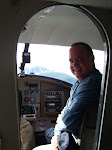
I was looking forward to working on landings and the traffic pattern this morning, but Rob and Mother Nature had other ideas. Rob wanted to review slow flight and stalls, and Mother Nature threw us a curve ball when it came time to work on landings.
We took a different airplane today. N54159 is another 1981 Cessna 172P, but without the Garmin 430 radio/GPS system of the other planes. For what we were doing it was fine. Well, almost fine. It had a finicky alternator and the rudder trim was a little off. Some 172s have a rudder that can be trimmed from inside the cockpit. Others, like the ones we have flown, have a manual trim tab that can only be adjusted on the ground. A little right rudder was required at almost all times today. I'm going to blame some of my difficulties today on that factor. Maybe not. There's an old saying that goes: a good carpenter never quarrels with his tools. On second thought, my problems were mostly my fault.
My stalls were a little rough. It's funny how fast newly acquired skills degrade. I'll be glad when I can practice these on my own. Rob wants to make sure I'm practicing the correct procedures. We did a set of steep turns, which went pretty well, and an emergency landing procedure over Egmont Key. Again, that went pretty well. We had a little wind today, so Rob decided to demonstrate the turn around a point. Pretty simple maneuver. You simply fly a circle around a point on the ground. The complications come with windy conditions. Your speed is constantly changing as you turn, so you have to vary the bank angle as you turn. I thought I did pretty well. If you notice the big circles on the GPS track of today's lesson, Rob did the first turn and I did the next two. They all look like good circles.
Rob had me run the whole landing as we headed back toward Albert Whitted. So, I headed north for the Don Cesar.
"Whitted Tower, Cessna 54158 over the Don, inbound touch and go."
"54158, make straight in runway 7, touch and go."
"Straight in runway 7. 54158"
Rob left me alone to get the plane ready to land. Once over I275, I reduced power and trimmed for level flight, 90 kts. From here on in, I visualized where I might be it the traffic pattern at the distance from the runway where I was. Reduce power, 1700 RPM, 10 degree flaps, pitch nose down. Reduce power, 1600 RPM, 20 degree flaps. It was about at this point we noticed that the wind had picked up a bit was somewhat across the runway. The wind was pushing me left of the runway. I can correct that in flight simply by turning slightly into the wind. My course would then be down the runway, but the plane would be pointed right of the runway. So, we decided that today would be a good day to start working on crosswind landings.
I guess I've been lucky so far to have the wind coming pretty much straight down the runway. Sooner or later, the wind and my luck had to change. The crosswind was not too strong, so Rob let me finish the first landing. It was not my prettiest. As I flared for landing, I eased up on the rudder to straighten the nose of the plane and I drifted left with the crosswind. Landing on the left side of the runway rattled me and I let the plane come down too hard. Full power and we're up again for another try.
Rob demonstrated his crosswind technique this time around. He likes to crab (the plane is pointed to the right of it's direction of travel) into the wind on final and then transition to a slip (uncoordinated flight where the plane slips or skids through the air) as he flares for landing. He has a little more experience at this than I have and what worked well for him, was a handful for me. My attempt at his technique was ugly. He decided that I might just try the slip on my final approach.
The slip worked better. Rob's concern with the slip is that it is uncoordinated flight (rudder and ailerons move in opposite directions) creating more drag and losing altitude fast. In fact, a slip is a method pilots use when they are too high or fast on final approach to kill altitude or airspeed. It is also easier and more dangerous to stall in uncoordinated flight. So, more power is needed if you want to descend at the normal rate. OK, I understand the concept, but the execution is still off a bit. I tried three landings this way, each one getting better, but none good enough.
We were out of time. I felt good about today's flight, even though I did not perform as well as I hoped. I was mentally set for working on the landing flare, but adding the crosswind component got me off my game. Rob said he has seen a lot worse. If so, I'm glad I wasn't in the plane. He did say that my landings were not all that bad and next week, if I get the flare right, I should solo. There is a tradition among pilots where the back of a pilot's shirt is cut off after his/her first solo. I was told not to wear a good shirt next week.
You will need to have google earth installed on your computer to open the lesson 6 file.
Statistics:
Dual Instruction Time: 8.0 hours
Landings: 26






1 comment:
I had a crosswind day recently too. My instructor had me do sideslips to land...it's different landing on one wheel, that's for sure. Good luck getting your flare back - I lost mine too and will hopefully find it next time up.
Post a Comment